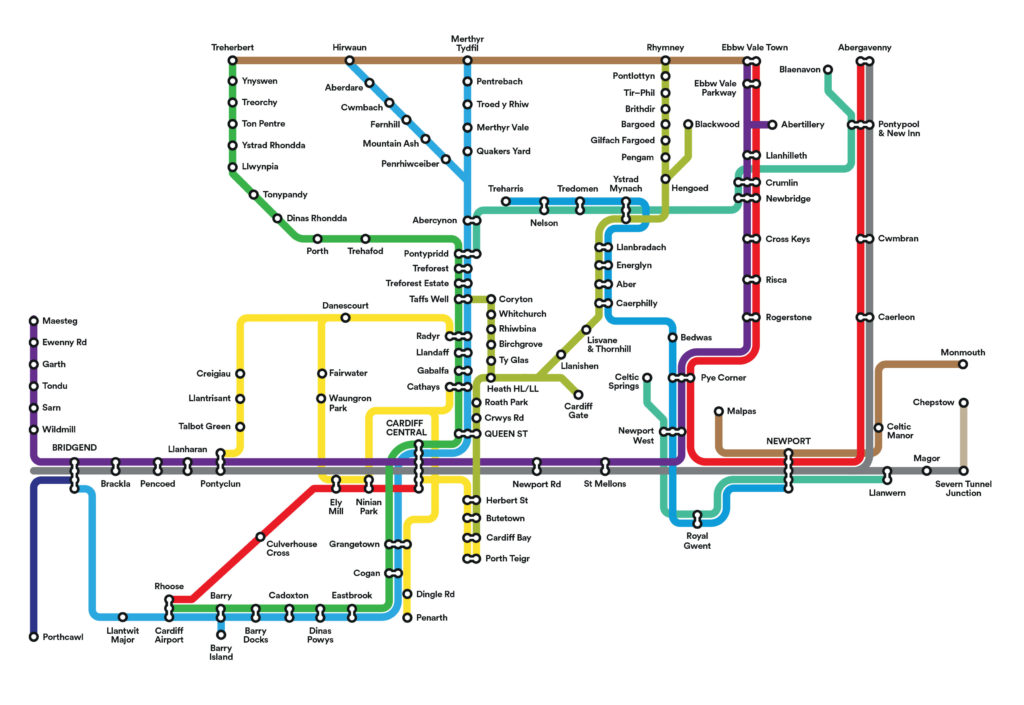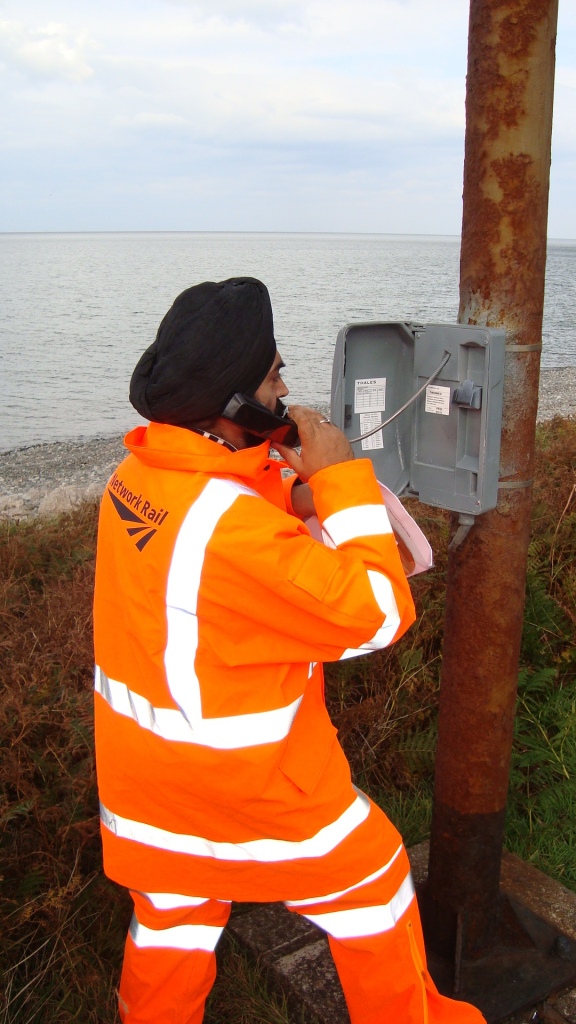The South Wales Metro (Metro De Cymru) is an integrated heavy rail, light rail, and bus-based public transport services and systems network under construction in South East Wales, around the hub of Cardiff Central. The project includes a brand-new depot at Taff’s Well, new trains, the electrification of the Core Valley Lines, new stations, and many other exciting new developments. This includes a new 10Gbit telecoms network which will be the heart and veins of the Metro, and which will deliver some new innovations. Rail Engineer recently met up with Alick McLeod, Amey Consulting Rail technical director (telecoms) who is leading the telecoms design assurance, to hear about the design and implementation.

Major investment
Three-quarters of a billion pounds is being invested to upgrade the railway lines to Aberdare, Coryton, Merthyr Tydfil, Rhymney and Treherbert, also known as the Core Valley Lines Metro. An integrated bus, rail, cycling and walking sustainable, integrated transport network is being created, to provide better-connected journeys, reduced journey times, and a greener way to travel. The new rolling stock will be a fleet of Stadler FLIRT innovative tri-mode multiple units, capable of diesel, electric, or battery traction.
The stations will include CCTV, ticket machines, and customer information systems. Along with robust communications for electrification and signalling control, all requires a flexible, high capacity, resilient, and converged telecoms data network. Transport for Wales (TfW) also wishes to have the option to provide telecoms links for the public benefit along the Valley Lines for social and economic purposes.
On completion, the project will improve the railway for the 1.5 million people who live and work in the Cardiff Capital Region with improved journey times and increased train frequency (from two trains per hour to four) on each of the Core Valley Line routes. From a depot at Treforest, TfW, Siemens Mobility, Amey Infrastructure Wales, Motion, Balfour Beatty and Allun Griffiths are working to deliver the project, which will include 50 new signals, over 300 axle counter sections and 98 signalling location cases in addition to the telecoms network and overhead electrification.
Fibre and IP routers
All the existing Core Valley Lines infrastructure is being transferred from Network Rail to TfW. An exception is the GSM-R radio and Fixed Telecoms Transmission FTN networks and interconnecting fibre cables, because they are part of the Network Rail telecoms network and cannot be easily divided. The telecoms equipment rooms however have transferred to TfW, with Network Rail having the right to access the rooms and Network Rail will continue to provide GSM-R radio coverage to TfW as a managed service. Currently, all the station customer information, Ticket Vending Machines and security (CCTV) systems are connected by expensive third party, leased, telecoms services, but this will change.

To support all the new Core Valley Lines telecoms requirements, including station information and CCTV, a new converged Multi-protocol Label Switching (MPLS) 10Gbit IP network and a 432-fibre cable network is being provided. In an IP network, MPLS uses ‘labels’ attached to the front of each packet to specify a virtual path for the IP packets to follow through the routing network. MPLS provides better latency for time critical applications, such as voice and video, and signalling related Solid State Interlocking (SSI), along with Virtual Private Network (VPN) capability for security. The label switching is done in hardware, rather than using software routing tables as in ‘normal’ IP. MPLS also provides Class of Service (CoS) to differentiate between time critical, high priority traffic (such as railway signalling) and delay tolerant, low priority traffic.
The network is being installed in stages, so some parts of the network will be connected by leased fibre (leased from Network Rail Telecom) until all the new TfW fibre is installed. To provide diversity of telecoms connections, the head of each valley will be connected by a 10Gbit ‘ring closure’ leased connection from a public telecoms operator. Similarly, in addition to 2 x separate and diverse TfW owned fibre cable spurs, a leased line telecoms connection will be provided to the integrated control centre at Taff’s Well to increase the availability of the telecoms network. A telecoms network management control centre will also be provided at Taff’s Well.
Security
Cyber security has been taken very seriously during the development stage of the project, as attempts to retrofit security solutions will almost certainly fail. A thorough threat analysis has been undertaken to consider both internal and external threats. Statistically, a network is more likely to be attacked from within rather than outside an organisation via disgruntled employees.
The MPLS-VPN for operational data is one mitigation against security threats, however a VPN alone is not designed for security so ‘defence in depth’ and additional measures, such as compliance with standards such as ISO/IEC 27000, ISA/IEC 62243, IEC 62531, BS EN 50159, and the provision of robust firewalls are also being put in place. A firewall is, in effect, a filter blocking unwanted network traffic and placing limitations on the amount and type of communications with other networks. All firewalls must be maintained and kept up to date, so a process is being established to ensure they are kept up to date in real time.
Having a 10Gbit telecoms network also means high quality station CCTV can be provided and comprehensive coverage of the network and stations has been included as part of the project.

No more copper
The 432-fibre cable consists of 36 ribbons of 12 fibres, which is more than enough to support the Core Valley Lines railway, so individual ribbons can be used to provide the local communities with ‘dark’ fibre or leased bandwidth from the IP network of routers and switches for social and economic purposes. Individual fibre ribbons will also be used for certain operational telecoms services, such as electrification control. The fibre cable, routers and switches used in the network will all be proven and approved for use on the main line network.
A traditional railway telecoms network will consist of trunk fibre and transmission equipment, along with twisted pair copper telecoms cables to provide local distribution to applications such as signal post and level crossing telephones. On an AC electrified railway, the copper cables will have to be immunised from induced voltages from the overhead catenary using aluminium screening conductors running alongside the copper cables, and careful bonding. This is expensive, both to provide and maintain, and is a major risk from being stolen. However, the Core Valley Lines telecoms network is being designed so that no long-distance copper cables and immunisation will be required.
There are currently approximately 200 lineside telephones used on the Core Valley Lines, but this will be reduced by 95%. The remaining 10 operational telephones and public telephones for User Worked Crossings will be designed to be Voice over IP (VoIP) instruments connected either by GSM radio, or via short Cat 5 cables to an IP node. The case to remove the majority of signal post and points telephones has been made by ensuring there is adequate GSM-R and public GSM radio coverage (via the 4x Mobile Network Operators with multi-network SIM cards fitted to mobile telephones) at all operational locations requiring communications.
The control centre at Taffs Well is being provided with a Cisco Unified Communications Manager (CUCM) for operational communications. This is a software-based IP call agent platform provided by Cisco Systems and is also known as Call Manager.
Call Manager provides telephony features and capabilities to packet telephony network devices such as IP phones, media processing devices, VoIP gateways, and multimedia applications. It provides the operators with modern state of the art communication services, such as unified messaging, multimedia conferencing, collaborative contact centres, and interactive multimedia response systems. It also has a suite of integrated voice applications and utilities, including an ad-hoc conferencing application, Call Detail Record (CDR) analysis and reporting tool, Real-Time Monitoring Tool (RTMT) and Tool for Auto-Registered Phone Support (TAPS).

More Amey innovation
A new Programable Logic Controller (PLC) depot solution has been developed for the Taffs Well depot. Amey Consulting Rail, Sella Controls, and Hima have been working for five years to develop a PLC safety case, and a partnership agreement for the introduction of the Hima PLC product into the UK has been agreed. Amey is now looking to develop a number of options and solutions using the Hima PLC, including control of the Taffs Well depot, using a commercial off-the-shelf (COTS) control screen solution. Other applications for the UK, such as interlockings, level crossings, and other signalling applications are also being developed.
Many railways are therefore looking to introduce COTS equipment. However, COTS equipment for signalling does need careful consideration as equipment designed for another industry or application may not deliver the required safety or performance requirements. This can be especially important for the rail industry, given the harsh vibration, extended operating temperatures, and electrical interference characteristics often found lineside and in rolling stock.
PLCs are widely deployed in other manufacturing and control system industries, and are rapidly becoming used for signalling. It is important that such systems use an open and flexible, but secure, data communication protocol, like the Core Valley Lines telecoms network, to support any future additional features and configuration.
Proven for use

Hima PLC devices are already proven for use in a variety of railway applications in other countries. These include interlockings, level crossings, and remote-control safe train movement systems. Unlike proprietary safety technology, the Hima COTS PLCs are standardised products but with SIL 4 approval (Safety Integrity Level 4 – the highest level). This allows Amey to develop their own SIL 4 applications conforming to UK signalling principles much more easily. The safety cases are built around Network Rail standards, BS/EN standards, and the Common Safety Method – Risk Evaluation and Assessment (CSM-RA) approach.
Amey had been looking at a number of PLC suppliers for some time, but Hima stood out as its PLC had been used throughout Europe for many level crossings and interlockings, and has been adopted in the Netherlands as a major interlocking solution. The Hima PLC has also been used in Austria, Germany, Belgium, Switzerland, Finland, Portugal, Greece, South Africa, and Australia. In the UK, the PLC has been also been approved for a correct side door enable and emergency traction discharge control in London Underground. Being already certified for SIL 4 for railway signalling helped in the acceptance of the safety cases. The PLC units come as interlocking and object controller units, so will be familiar to most signalling designers.
Summary
The new innovative telecoms network is key to electrifying the key valley routes north of Cardiff. The electrification will bring all the benefits of electric trains, such as faster acceleration, greater comfort and cleaner, greener travel, as well as greater reliability, to the rail users in South Wales.
The area’s dense rail network plays a vital economic and social role, providing important links between settlements in South Wales. The Metro scheme is predicted to have a significant effect on the economy of Cardiff and the Valleys – deepening labour markets, improving connectivity and enhancing the attractiveness of the area to investors.


